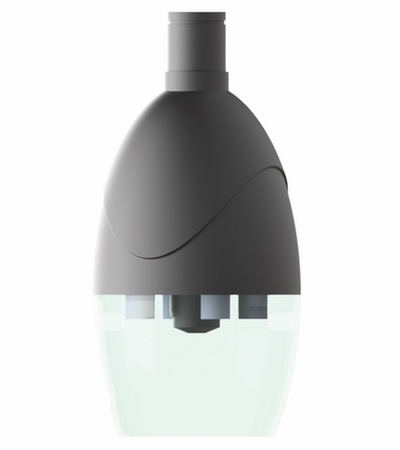Cleanrooms are unique because these are production spaces with controlled contamination. Cleanrooms are classified environments that guarantee the presence of microorganisms and inert particles is lower than a specific number per unit of volume. Microorganisms are present in the air and on surfaces: bacteria, fungi and protozoa, and just like some viruses, they can survive in the aerial space. They are airborne from the convective movements of the air in the form of bioaerosols, binding to dust, liquid particles or other naturally occurring contaminants.
It is due to these criteria that cleanrooms have particular construction and maintenance specifications: they are built to minimise the introduction, generation and retention of airborne particles inside the ambient, allowing activities sensitive to contamination. The design must be such as to minimise the introduction of particulate sources: smooth, waterproof and uninterrupted surfaces, steel furnishings, bevelled edges, low particle release materials.
Cleanrooms are built following the "dynamic containment" technique in which the atmosphere of the rooms should be kept in constant overpressure and controlled with an increasing gradient towards the areas with the highest cleanliness to avoid the introduction of potentially contaminating inverse flows. Differential pressures are continuously monitored using pressure gauges.
Cleanrooms are designed to guarantee the flow and the degree of purity of the air
Relevant parameters are monitored: temperature, humidity, number of particles, and differential pressures between the rooms. In all operating conditions, filtered air ventilation must maintain a positive pressure compared to the surrounding lower-class areas and guarantee an adequate air exchange. Cleanrooms are designed to guarantee the flow and the degree of purity of the air, required by legislation, both "at rest" (completely installed system and in operation, absence of operators) and "in operation" (system in operation in the established mode with the presence of a specific number of operators).
The cleanroom must meet the standards of cleanliness, which are defined by the class verification. Production must take place in environments where personnel, material and equipment are accessed through air-tight compartments, which must be kept clean and properly ventilated.
Biodecontamination methods
The disinfection of a controlled environment involves the reduction and deactivation of microorganisms present on the room surfaces, as well as on those of the machines and instruments present in it. It is important to define the critical factors that generally influence the choice of the biodecontamination method and that characterise most of the controlled environments.
In terms of the environments, the optimum temperature is > 20°C. A decrease in temperature reduces effectiveness. The relative humidity of the area in which the disinfectant is to act also plays a part.
The nature of the material is another factor to consider, including porosity, presence of organic material, and coating of the bacterial surface.
Fumigation of clean areas may be useful for reducing microbiological contamination in inaccessible places
Next is the disinfectant. The concentration of the active ingredient, the application time (contact with the material), and the water quality of the sanitising solution are all part of the equation.
One of the most useful tools for microbiological risk assessment is the classification of pathogens into risk groups.
Organism can be categorised by:
- By type
- Gram-negative bacteria are generally more resistant than gram-positive to disinfectants and antiseptics
- Mycobacteria, endospores and protozoan cysts are resistant to disinfectants and antiseptics
- Viruses without envelopes are generally more resistant to disinfectants and antiseptics compared with enveloped viruses
- Microbial load
- By organisation
Other factors that must also be considered are:
- Pathogenicity of the agent and infectious dose
- Natural mode of transmission
- Other methods of transmission resulting from laboratory manipulation (parenteral, swallowed aerial)
- Persistence of the agent in the environment
- Concentration of the agent and volume of the concentrated material to be handled
- Planned laboratory activities (i.e. sonication, aerosol generation, centrifugation)
Therefore, before choosing a valid biodecontamination method, it is necessary to evaluate:
- Activity: bactericidal, fungicidal, sporicidal, virucidal
- Speed of action: sterilisation achieved in a short time
- Penetration: ability to penetrate the treated material or the packaging in which it is contained
- Compatibility: it does not cause significant structural or functional changes to the material following repeated treatments
- Non-toxic: safe for the operator and the environment
- Resistance to organic material: effectiveness unchanged in the presence of organic material
- Cost-effectiveness: reasonable costs for equipment, installation and use
Guidelines and regulatory
Regarding sanitation, the 37 article in the EC Guide to Good Manufacturing Practice – Revision to Annex 1 – Manufacture of Sterile Medicinal Products - Septembre 2003, states: "The sanitation of clean areas is particularly important. They should be cleaned thoroughly in accordance with a written programme. Where disinfectants are used, more than one type should be employed. Monitoring should be undertaken regularly in order to detect the development of resistant strains.
Article 38 states: "Disinfectants and detergents should be monitored for microbial contamination; dilutions should be kept in previously cleaned containers and should only be stored for defined periods unless sterilised. Disinfectants and detergents used in Grades A and B areas should be sterile prior to use."
Also, article 39 states: "Fumigation of clean areas may be useful for reducing microbiological contamination in inaccessible places."
Understanding the process
The biodecontamination of a controlled environment includes three main steps:
- Cleaning phase: the use of detergents ensures the removal of any processing residues and "dirt" attached to the surfaces to favour the action of the sanitiser. For the same reason, once the detergent is used, it is essential to remove the residues that it leaves.
- Manual disinfection phase: disinfectant rotation involves the use of one or two products with bactericidal/fungicidal activity and the use of a sporicidal product at least monthly.
- Fumigation phase: decontaminating agents are diffused into the environment so that they can reach points otherwise inaccessible.
One of the most used methods of biodecontamination is the application of hydrogen peroxide (H2O2) as a sterilising agent. It has become the preferred technique in the pharmaceutical sector because it represents a valid alternative to substances that have been more widely used in the past, which are now recognised as very dangerous for human health, such as fumigation with formaldehyde, peracetic acid, chlorine dioxide, and ozone.
Formaldehyde, as well as phenol, have significant disinfectant effectiveness; however, they are are not only carcinogenic but present additional contraindications: after fumigation, the area must be thoroughly ventilated before personnel are allowed to enter. No method can quickly demonstrate the absence of residues.
For many years, the predominant choice for the so-called "cold" sterilisation has fallen on ethylene oxide (EtO), which acts on the functional groups of structural proteins. Its effectiveness and compatibility with materials are relevant, but ethylene oxide is a carcinogenic gas, hazardous due to being odourless, flammable, and explosive. Furthermore, objects sterilised with EtO must be subjected to degassing and not used for at least 48 hours.
Hydrogen peroxide comes to play
Hydrogen peroxide (H2O2) is a strong oxidant with a high antimicrobial power both against a large number of bacteria and for bacterial spores that are most resistant to biodecontamination.

ZHEROX by AM Instruments is a biodecontamination system designed to apply a mist of hydrogen peroxide precisely and effectively
At room temperature, H2O2 is a colourless, viscous liquid and somewhat stable. It solidifies at low temperatures and quickly decomposes by converting to water and oxygen. H2O2 is never used pure, but in aqueous solution in percentages never exceeding 60%. By increasing the concentration, the solution becomes corrosive.
Hydrogen peroxide systems were developed in the early 90s to fight against the bacteriological war and terrorism. The need for a practical, rapid and safe biodecontamination became pressing. Only later did hydrogen peroxide systems play a decisive role in the industrial and health sector, and the most used of
H2O2 for biodecontamination is vapour. The application is known as vapourised hydrogen peroxide and is commonly referred to as VHP.
The VHP application relies on a high concentration in the vapour phase, which is achieved through the initial dehumidification of the air. The process uses 30-35% hydrogen peroxide solution, which is rapidly brought to evaporation to reach the required vapour concentration. However, problems can occur in large environments, since it is difficult to have a uniform degree of microbiological abatement. The concentration at 30/35% makes necessary to carry out the operations with considerable attention, too. The ideal solution to this application is achieved by using a hydrogen peroxide solution that is ionised through an electromagnetic field. A solution of hydrogen peroxide of less than 8% is dispensed through a nozzle, creating a mist of microdroplets, which are then passed through a high-voltage electromagnetic field that ionises the H2O2 fog. The solution spreads rapidly throughout the space, killing all the microorganisms present in the area. This technique offers several advantages:
- Solution produced with the plasma technique
- Effective against bacteria, fungi, moulds, spores and viruses
- Microbial efficacy with low contact times
- Compatible with all types of materials
- Mist at a concentration of <8%
- Sterilisation of environment to 6 log reduction
- Cost in line with other sporicidal products
How it works
Due to ionisation, the resulting solution has a high concentration of hydroxyl radicals and reactive oxygen species (ROS), which damage microorganisms through the oxidation of proteins, carbohydrates and lipids. This effect leads to cellular dysfunctions and allows a rapid biodecontamination in targeted areas.
The electromagnetic field imparts an electrostatic charge to the mist, which acts as a gas due to mutually repulsive positively charged particles.
The ideal application is achieved by using a hydrogen peroxide solution that is ionised through an electromagnetic field
The result is an extremely high diffusion property to reach 100% of the entire area and surfaces quickly. The by-products of the hydrogen peroxide solution, oxygen and water, don't leave residues on the surfaces. Cleaning is not required as the by-products are much safer to handle than those left by other conventional methods.
AM Instruments, the Italian company at the forefront of contamination control for 30 years, has recently designed and implemented a biodecontamination system that applies this method precisely. The ZHEROX system, based on ionising electromagnetic fields, has not only proved effective and safe but can act in spaces of great extension thanks to the possibility of employing multiple devices that interact with each other, acting autonomously through the remote control of a single "master" machine.
Entirely designed and built by AM Tech, part of AM Instruments, the new system for environmental biodecontamination can sterilise up to 300 cubic metres with a single unit and fully traceable process. If the volume of the area is bigger than 300 cubic metres, it is possible to use more than one machine at the same time.

Cristina Masciola
The nebulised substance passes through an ionising energy source consisting of an electromagnetic field, which increases the effectiveness of biodecontamination effect and ensures a better distribution.
The equipment is automatically interconnected via WiFi and managed by a "master machine, allowing the diffusion of the nebulisation to be optimised and cycle times to be reduced.
The biodecontamination cycle, configured or recalled from the memory, can be started by the integrated touch screen. The start can be delayed with a built-in countdown to allow the operator to leave the room before the beginning of the nebulisation. The process can also be started by connecting to the machine remotely via any mobile or fixed device, thanks to a web server on the machine.
The system guarantees the total traceability of all operations as every step performed on the machine is memorised and made available for consultation and the generation of reports. The process of entering or modifying the operating parameters, configuration, maintenance, users, and data of the sanitiser used is tracked consistently and punctually.
N.B. This article is featured in the October 2019 issue of Cleanroom Technology. Subscribe today and get your print copy!
The latest digital edition is available online.




